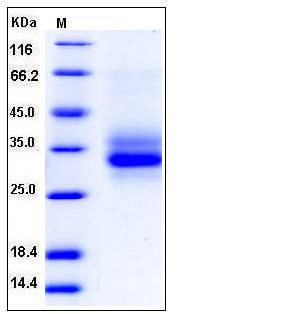Mouse CLEC7A / Dectin-1 / CLECSF12 Protein (His Tag)
beta-GR,BGR,Clecsf12
- 100ug (NPP3291) Please inquiry
| Catalog Number | P50233-M07H |
|---|---|
| Organism Species | Mouse |
| Host | Human Cells |
| Synonyms | beta-GR,BGR,Clecsf12 |
| Molecular Weight | The secreted recombinant mouse CLEC7A consists of 193 amino acids and has a calculated molecular mass of 22.5 kDa. As a result of glycosylation, the apparent molecular mass of the recombinant protein is approximately 30-37 kDa in SDS-PAGE under reducing conditions. |
| predicted N | His |
| SDS-PAGE |  |
| Purity | > 95 % as determined by SDS-PAGE |
| Protein Construction | A DNA sequence encoding the extracellular domain (Phe 69-Leu 244) of mouse CLEC7A (NP_064392.2) was fused with a polyhistidine tag at the N-terminus. |
| Bio-activity | |
| Research Area | Cancer |Invasion microenvironment |Adhesion molecule |Cell adhesion |Lectin |C-tyep lectin | |
| Formulation | Lyophilized from sterile PBS, pH 7.4 1. Normally 5 % - 8 % trehalose, mannitol and 0.01% Tween80 are added as protectants before lyophilization. Specific concentrations are included in the hardcopy of COA. |
| Background | Dectin-1 was recently identified as the most important receptor for beta-glucan. It is a type II transmembrane protein which binds beta-1,3 and beta-1,6 glucans, and is expressed on most cells of the innate immune system and has been implicated in phagocytosis as well as killing of fungi by macrophages, neutrophils and dendritic cells. Recognition of beta-glucan by dectin-1 triggers effective immune response, including phagocytosis and proinflammatory factor production, to eliminate infecting fungi, which especially benefits immunocompromised patients against opportunistic fungal infection. In addition, dectin-1 is involved in the adaptive immune response as well as autoimmune diseases and immune tolerance. Dectin-1 can recognize and respond to live fungal pathogens and is being increasingly appreciated as having a key role in the innate responses to these pathogens. In addition to its exogenous ligands, Dectin-1 can recognize an unidentified endogenous ligand on T cells and may act as a co-stimulatory molecule. Recent studies have highlighted the importance of Dectin-1 in anti-fungal immunity, in both mice and humans, and have suggested a possible involvement of this receptor in the control of mycobacterial infections. |
| Reference |
